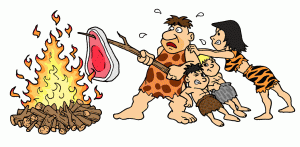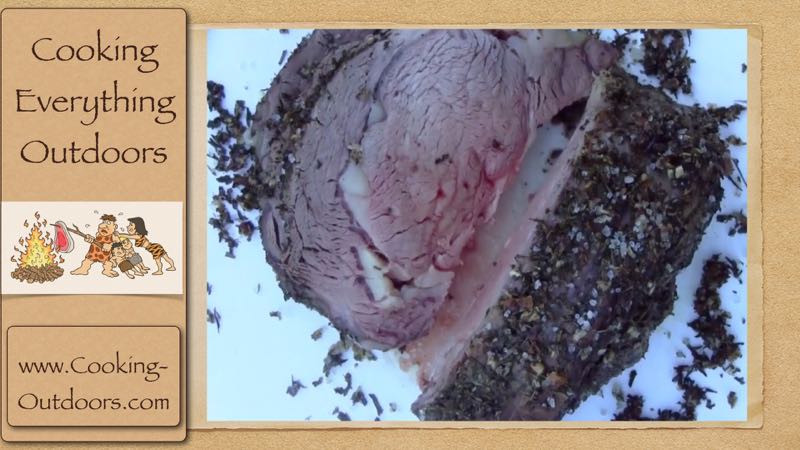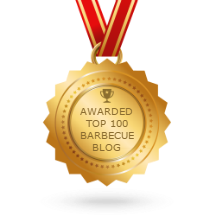Dutch oven Salt Crusted Prime Rib Video
(Closed Captioning available on this video)
- Serves: 8
- Serving size: 1
- Calories: 741
- Fat: 36 g
- Saturated fat: 12.8 g
- Carbohydrates: 15 g
- Sugar: 0.1 g
- Sodium: 894 mg
- Fiber: 1.4 g
- Protein: 82 g
- Cholesterol: 201.3 mg
- Prime rib 5 Pound, bone in
For the wet rub- 3 tbs Fresh rosemary
- 12 Garlic cloves, minced
- 1⁄2 Cup (8 tbs) Herbes de provence
- 1 tbs Fresh pepper
- 2 tbs Extra virgin olive oil
- Prepare the dutch oven with about an inch thick layer of rock salt.
- In a bowl, combine all the ingredients for the wet rub and mix well.
- Using your hands, pat the wet rub on the prime rib to coat evenly.
- Insert a remote thermometer in the prime rib.
- Place the prime rib in the Dutch oven and cover it with about an inch of rock salt as shown in the video.
- Place the coals on the rim of the Dutch oven and allow to cook.
- Keep a check on the remote thermometer, it will take about 2 to 2.5 hours for the prime rib to cook to medium-rare.
- The internal temperature should be 130 degrees.
- Carefully remove the lid of the Dutch oven and gently scrape the rock salt.
- Allow the Prime rib to rest for about 20 minutes.
- Carve and serve.
Video Transcript:
Presenter:
Hey, everyone, today I’m going to be cooking a highly requested item, salt crusted prime rib in the Dutch oven on the Cooking Everything Outdoors show.
Gary House with the outdoor cook Cooking Everything Outdoors show, I hope you try this at home.
So let’s go over the tools that I’m going to be using and it’s pretty simple.
First off, I’m going to be using a 12 inch Camp Chef deep Dutch oven and I’m going to be using rock salt.
I’ve already put about an inch of rock salt on the bottom.
Now what I have is a 5 pound bone-in roast prime rib.
Basically, the Butcher has already trimmed the bone for me.
Now, on our prime rib we’re going to put a… what’s called the wet rub.
The ingredients for our wet rub are about 3 tablespoons of fresh, chopped rosemary.
10-12 garlic cloves, minced.
This is Herbs de Provence.
And it is a mixture of herbs with some salt that’s added to it, and about a tablespoon of coarse black pepper, and some good extra virgin olive oil.
So let’s put our wet rub together.
To start off with, we have our Herbs de Provence.
And that’s probably a good 1/2 a cup there.
I’m going to add my garlic, my pepper, my rosemary.
Let’s just give this a quick dry mix.
And then we’ll start adding our oil.
And just do enough to where I get what’s called a wet mix.
You’ll know you’re done when it… some holds its shape.
So now what you want to do at this point, we’re ready to apply the wet rub to the prime rib.
You want to get your charcoal going.
Now, we have a 12 inch Dutch oven.
So that’s going to mean 24 coals, we’re going to need.
And so get that going in your charcoal chimney.
I have mine setup to the site here.
It’s starting to heat up right now.
So roll up your sleeves and start packing this on.
I think, you know, you could spoon it on very delicately and dangly, but really the best way to do this is to just get in there and add a little more oil to this and pack it on with your hands.
And I want a pretty decent crust on this.
Just pad it on there as best you can.
Eventually you’ll get a nice, rich herbed coating on your prime rib.
And that, my friends, is what I like.
So now we want to add our prime rib to our Dutch oven.
Lid off, take our prime rib and set it right on the salt.
You’ve got extra seasoning and touch here and you want to pad that on there and add that on.
Go for it.
So now we need to add the salt.
But before you do that it’s really, really important that you get a remote thermometer and insert the probe in right about now because otherwise, you’re not going to know what temperature your roast is cook to because they’re all going to cook at a different time.
Today it’s a little cold, it’s a little windy, it’s going to slow things down a bit.
But get your remote thermometer and get a probe in there right into the thickest part as best you can judge it.
We’re just going to fill up the whole Dutch oven, around the roast, fill up cavity completely.
And I’m going to try… hopefully I’ll have enough room to get of about an inch of salt on the top of this also.
So there we have it filled up and our lid just barely fits, got about an inch of salt on that and we’re just going to close this up and start cooking.
Okay, so I’m going to need about 8 coals on the bottom.
Get our Dutch oven on there and, boy, oh boy, it’s just heavy.
Probe will have that hooked up in just a second and now I want to add my top coals.
And we’ll need to have to go around the rim about 14 coals there.
Okay, that’s our setup.
So the coals are on the Dutch oven.
It’s going to be heating up.
We’re shooting for about 350 degrees.
And, you know, that’s somewhat speculation with the Dutch oven.
It’s going to get there and it’s going to keep that temperature for, you know, good 40-45 minutes or so.
At first it’ll be higher than that then it’ll creep down.
So it’s sliding scale on this.
But optimally we’re going to get about an hour of our… 45 minutes to an hour with this set of coals.
And we’re going to be cooking our prime rib to about 130 degrees, so that way I can pull it, it’ll rest for half an hour, come up in temp, so we’re going to be heating around 140 is my guess which is about medium rare, just what most people like their prime rib at.
And that I’m going to guess is going to take a couple of hours.
But we’re going to watch the thermometer.
I can’t really just judge this.
So I’m going to keep my eye on my remote thermometer.
I’m going to add coals as needed.
And then we’re going to have ourselves a beautiful prime rib.
So it’s been about 2 1/2 hours.
Our prime rib temperature is at right at about 129 right now.
So what I’m going to do is I’m going to pull all of these off and take a look at this.
And I think we’ve got… I mean the smells are just incredible, but I think we’ve got a winner here.
Alright, the first official peak.
I think all we’re going to see is a bunch of cooked salt in there.
Well, there you go, there’s the timer just hit 130.
Sweet.
Let’s see how we did.
Oh man.
Alright, yeah, there’s a big pile of salt.
You can see some of the herbs and stuff have come through.
The smell I have to tell you that it is phenomenal.
Well, let’s get some of this salt off of here.
It’s just going to peel off.
Sometimes it comes off in a big crust if you get your salt really, really wet ahead of time.
I didn’t do that.
I just basically want to get as much of this, good thing we’re cooking outdoors here off as possible.
Alright, so let’s see what we can do here.
Okay, now what I’m going to do is I’m going to knock off a little bit more of the salt.
And then we’re going to let it rest for 20 minutes or so and we’ll cover it up.
Alright, the sun’s going down fast.
We cooked our prime rib.
It’s set for about 20 minutes now as I’m kind of picking up things around here.
You know, I’ll just cut into a chunk of this.
3 strings if I remember right.
Let’s see here.
So, that should release our prime rib from the bone like so.
It’s a good sign.
Look at the juices in that, just coming out of that.
Wow.
Spectacular.
It’s so tender.
Wow.
For those of you that think that salt has leached into this prime rib, that’s not the case at all.
There’s a salty taste to the crust but not in the meat.
And the salty taste to the crust is only from the salt that I added to the wet rub.
So there it is, everybody, that is the salt crusted prime rib cooked in a Dutch oven that you’ve been asking for.
I hope you enjoy this.
Anyway, that’s it.
Take care.
I’ll see you later.
Thanks for watching.
Hey, I hope you enjoy this episode of the Cooking Everything Outdoors show.
But without my sponsors none of this would be possible, Camp Chef and www.OutdoorCooking.com and Island Grillstone at www.IslandGrillstone.com.
They make all of this possible.
And they’re great companies.
And they’ve got super good product and really good customer service.
So please take a minute and go visit them.
Say thank you and buy something.
If you want to find out more about me, you can visit me on Pinterest, Facebook, Twitter, YouTube, iTunes and of course, www.Cooking-Outdoors.com where I’m always cooking up something new.
This is Gary House.
And I will see you when I see you.




Why encrust prime rib in rock salt for dutch oven cooking if the salt is not flavored into the prime rib? According to your comments, only the rub is incorporated.
This looks good I’ll have to try it when I get a Dutch Oven.
The salt adds an additional layer of insulation that helps keep the flavor and juices in the roast. I am sure there is a more scientific method behind this answer but I don’t know it.
You’ll love it! The flavors are so amazing!
Hi Gary, That looks so good.
Can I use any kind of rock salt. I don’t know if this is food grade salt but will this stuff they sell at walmart work?
https://www.walmart.com/ip/Morton-Salt-Solar-Salt-40-Lbs/16674416
Mike, looking at the bag you linked to, that would be perfect. As long as it is 100% salt, you are good to go!